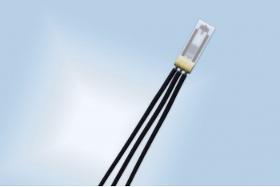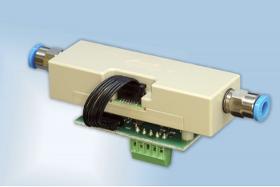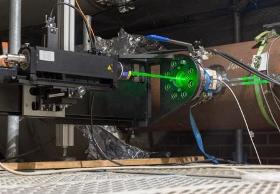- europages
- >
- COMPANIES - SUPPLIERS - SERVICE PROVIDERS
- >
- fs – flow sensors
Results for
Fs – flow sensors - Import export

INNOVATIVE SENSOR TECHNOLOGY IST AG
Switzerland
The IST AG FS7 thermal mass flow sensors are the successors of the FS5 flow sensors and exhibit a symmetrical heater design and enhanced sensitivity. The FS7 flow sensor is applicable in gas and offer excellent long-term stability. The small thermal mass of the FS7 sensor provides a fast response time. Additionally, the standard FS7 sensor is also available with a housing which is easily implemented into various applications. Further advantages of the FS7 thermal mass flow sensor include: — Easy adaptation in various applications and housings — Excellent long-term stability — Simple signal processing — Simple calibration — Stable platinum technology — Excellent reproducibility — Customer-specific sensor available upon request. The IST AG FS7 flow sensors are optimal for measuring gas flow in various flow applications.
Request for a quote
INNOVATIVE SENSOR TECHNOLOGY IST AG
Switzerland
The IST AG FS2 flow sensors are applicable in gas and offer excellent long-term stability. In addition to measuring flow rates, the FS2 gas flow sensor is able to detect flow direction with outstanding sensitivity. Further advantages of the FS2 thermal mass flow sensor include: — Simple signal processing — Simple calibration — Bare sensor resists up to +450 °C (customer specific) — Stable platinum technology — Excellent reproducibility — No moving mechanical parts — Customer-specific sensor available upon request The IST AG FS2 flow sensors are optimal for measuring gas flow and direction.
Request for a quote
INNOVATIVE SENSOR TECHNOLOGY IST AG
Switzerland
The IST AG MicroFlowSens (MFS) technology was developed for fast flow measurements. Due to the membrane system, the thermal mass is reduced to the minimum resulting in a very fast response time and low power consumption. In addition to measuring flow rates, the MicroFlowSens offers an outstanding sensitivity and is able to detect flow direction. The MFS flow sensor is optimal for limited space system integration and is available as integrated sensor on a PCB. Further advantages of the MFS thermal mass flow sensor include: — Excellent solution for applications with high flow rates and fast response time in CTA mode — Very high measuring dynamic with CTA mode (10'000'000 : 1) without bypass — Excellent for the measurement of very low flow rates and leakage detection with bridge mode — High chemical resistance against aggressive gases and vapors — Different sensitivities, circuit topologies available — Detection of flow direction — Customer-specific sensor layout upon request
Request for a quote
INNOVATIVE SENSOR TECHNOLOGY IST AG
Switzerland
The IST AG FS7.4W gas flow sensor has been developed for applications with temperatures up to 400 °C. The design of the FS7.4W is based on the FS7 design which offers a symmetrical heater that enhances sensitivity. The FS7.4W flow sensor is applicable in gas and offers excellent long-term stability. The small thermal mass of the FS7.4W sensor provides a fast response time. Further advantages of the FS7.4W thermal mass flow sensor include: — Easy adaptation in various applications and housings — Excellent long-term stability — Simple signal processing — Simple calibration — Stable platinum technology — Excellent reproducibility — Customer-specific sensor available upon request The IST AG FS7.4W flow sensors are optimal for measuring gas flow in various flow applications.
Request for a quote
INNOVATIVE SENSOR TECHNOLOGY IST AG
Switzerland
The IST AG SFS01 EvaKit offers an easy evaluation of the SFS01 gas flow sensor. It has both analog and digital output (I2C) and allows a fast and flexible evaluation of the SFS01 sensor. The I2C output includes both raw values and calibrated flow values from 0 to +-200 sccm. Further advantages of the SFS01 EvaKit include: — Excellent measuring dynamics — Analog output of raw signal — Digital output with raw signal and fully calibrated signal — Integrated flow channel with pneumatic connections
Request for a quoteDo you sell or make similar products?
Sign up to europages and have your products listed

MICROCYBER
China
Parameters Basic Parameters Bus Power Supply: 9~32VDC Current consumption (static):≤14mA(FF/PA) 11V~35 VDC(HART) Input Signal: Pt100, Pt1000, Cu50, Cu100 Ω, 0, 0 to 500 ~ 4000 Ω Resistance, B, E, J, N, K, R, S, T eight degrees of Thermocouple, -100mV ~ 100mV Voltage Signal The Channel Number: Single Channel Fieldbus Protocol: FF/PA/HART Insulation: Between the Terminal and the Housing:500Vrms(707VDC) Operating Temperature: -40℃~85℃ Humidity Range: 0%~95%RH Starting Time: ≤5secs. Turnover Time: 0.5secs. Electromagnetic Compatibility: In Line with the GB/T 18268-2010 Explosion-Proof Sign: Ex ia IIC T4 Ga (HART)
Request for a quote
OMEGA AIR
Slovenia
Thermal mass flow sensor OS 401/OS421 is suitable for consumption measuring in different compressed air systems. The version with a display shows the volumetric flow and the total compressed air consumption. The keyboard enables setting of tube diameters and consumption counter. Various settings such as gas type, flow unit, reference standards, can also be set.
Request for a quote
OPTOLUTION MESSTECHNIK GMBH
Germany
Large heat and flow meters are often used continuously for decades after an initial calibration at external test benches. A recalibration of these meters within their actual operation conditions was not possible so far. In the best case scenario those flow meters are unmounted and recalibrated on an external test bench. Drawback of this method is an interruption of supply in addition to its already high costs. Furthermore, calibration conditions can differ greatly from actual operation conditions compared to test bench conditions, so even if calibrated, the measurement uncertainty in operation remains fairly unknown. This often leads to more difficult fluid distribution optimizations and leaves billing fairness to a gamble. More precisely measured values of flow sensors may uncover hidden saving potentials within the fluid distribution system and allow more exact performance indicators, improving energy efficiency.
Request for a quote
IPF ELECTRONIC GMBH
Germany
The function of the flow sensor is based on the calorimetric principle. The probe is heated up from the inside a few degrees Celsius in relation to the flow medium, in which it protrudes. When the medium flows, the heat generated in the probe is dissipated through the medium. The temperature within the sensor is measured and compared with the likewise measured medium temperature. From the obtained temperature difference the flow state of each medium can be derived. These sensors are applied in areas such as monitoring of cooling systems, ventilation systems, pump dry running by checking the presence of liquid or gas flows.
Request for a quoteResults for
Fs – flow sensors - Import exportNumber of results
10 ProductsCountries
Company type